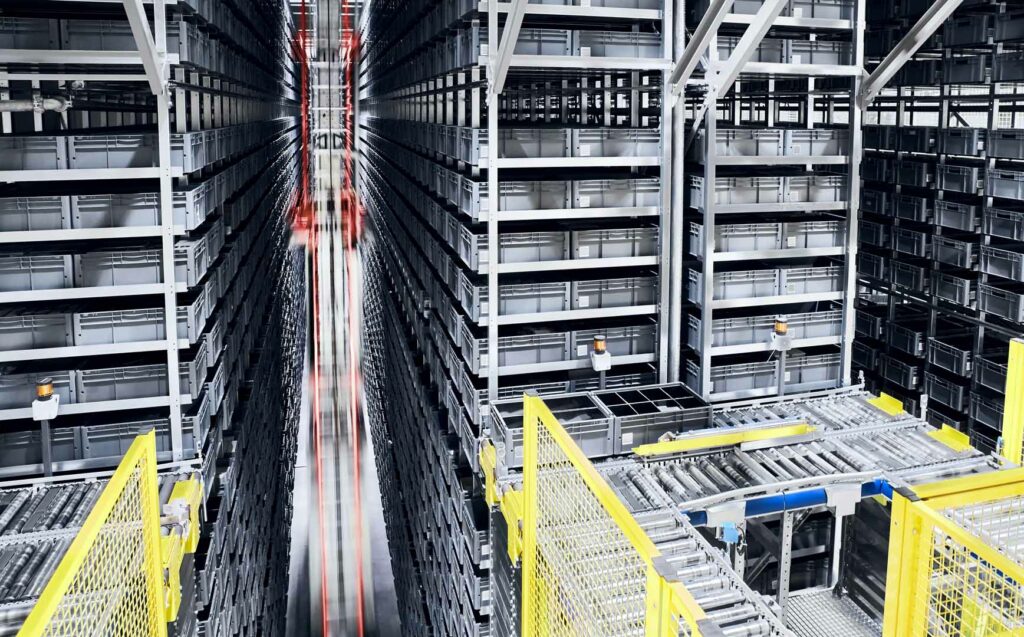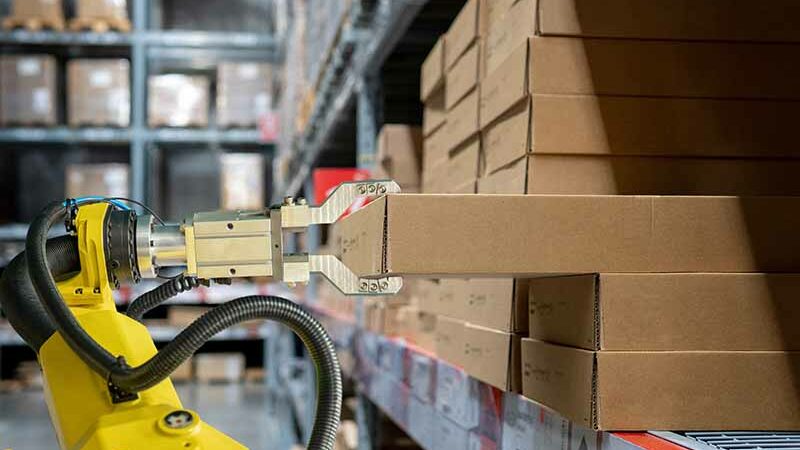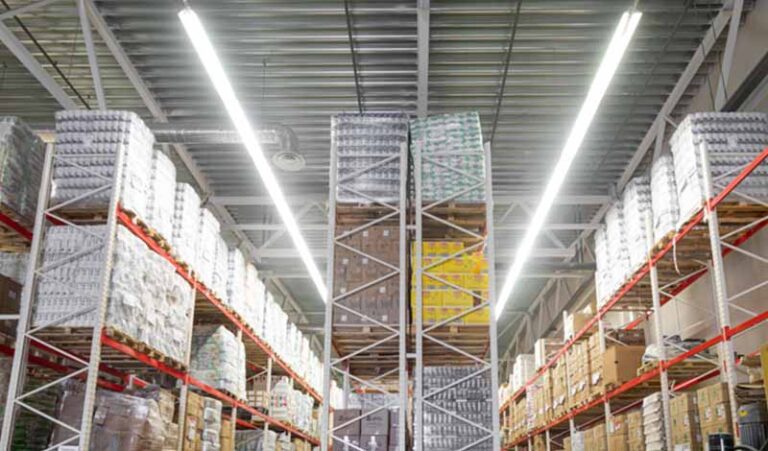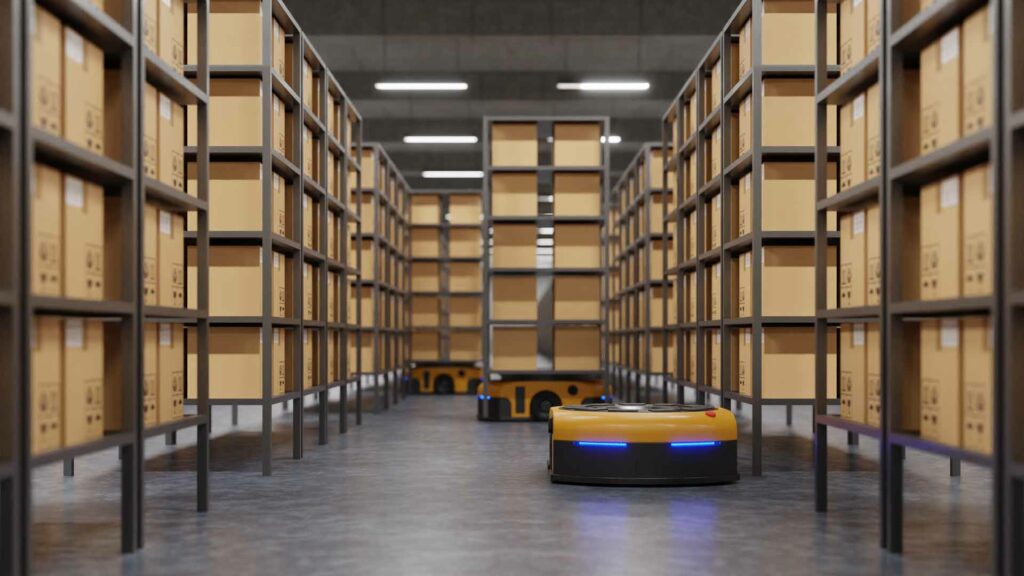
Businesses today want to boost productivity and efficiency while cutting costs and reducing hard labor. Because of this, robots and automation are becoming the next big thing for warehouse operations.
But what does this mean exactly? How are these robotic systems and automated features showing up this year and beyond? Let’s explore some of the latest trends in warehouse automation.
Automation in warehouses and distribution centers isn’t new; it’s been around for many years. However, we’re now entering a new phase in robotic solutions called augmented intelligence. This will be a big trend in warehouse automation in the coming years.
Instead of just using robots to handle time-consuming tasks, employees will start working alongside smart machines and systems. Workers and robots will team up on tasks as automated systems become smarter. These collaborative robots are changing how we approach warehousing and redefining the roles of warehouse workers.
This shift towards augmented intelligence means that human workers are still very important, but now they’re helped by artificial intelligence (AI) and smart machines. Warehouse operators can focus on more complex tasks while robots handle repetitive duties, leading to improved safety and efficiency.
Data is critical when designing and using robotic systems. This has always been true, even from the early days of automation. Teams have tried to use facts and figures to improve efficiency and productivity.
However, big data is now arriving rapidly. Businesses need to manage and use this data effectively.
More and more, the use of cloud-based platforms is becoming one of the key trends in warehouse automation. Automated systems can work somewhat on their own, but there still needs to be a way for human teams to manage automated processes and watch over operations.
This platform also needs to collect data from automated solutions. Businesses will use this data to maintain and upgrade the solution over time. Because it’s cloud-based and remote, it’s easier to manage and coordinate processes across multiple sites, using data delivered in real-time.
By using cloud technology, warehouse operators can access information from anywhere, improving inventory management and decision-making. This approach reduces errors and improves communication across the supply chain.
One of the key automation trends in warehouse operations is a new way of thinking. Facility management teams are moving away from seeing automation as just one big thing. Instead, they are considering the different ways automation can be applied.
We can split automation into two main types—digital automation and physical automation. Companies of all kinds can use digital automation, but warehousing operations need to focus on both types.
This means automating digital processes like project management, customer service, and scheduling, as well as physical tasks like picking and packaging. Even though these types of automation might be developed and used separately, they need to work together as part of a company-wide system.
By combining digital and physical automation, businesses can create a more efficient and connected automated warehouse environment. This integration leads to cost savings and improved productivity.

Retrieval and storage need to be reliable and predictable. Mistakes in these processes can be hard to fix and may end up costing the business money. Because of this, automated storage and retrieval systems are becoming a key focus in the development of robot technology.
With these systems in place, businesses can effectively eliminate the risk of error. The processes of product handling, picking, and packaging become much more streamlined and cost-effective. As a result, time, effort, and resources are saved across the supply chain.
Warehouse robots can store and retrieve products with minimal human intervention. This not only reduces errors but also increases storage density within the warehouse space. By optimizing the use of space, businesses can handle more inventory without needing more facilities.
Automation greatly improves efficiency in warehouse operations and across the supply chain. This happens by taking time-consuming and repetitive tasks out of the hands of human workers and letting robots and automated systems take over. This leads to more predictable results and better reliability.
Also, teams are free to use their skills in other areas of the business. Rather than replacing human workers, automation allows these teams to focus on tasks better suited to their abilities. This, in turn, results in better support for—and morale among—these human staff members.
For example, warehouse workers might shift their focus to inventory management, quality control, or overseeing automated systems. This change leads to reduced errors and enhances overall operational efficiency.
Advances in robotic technology are leading to new business models in the industry. Warehouse facility managers need to do more than just buy and set up a piece of autonomous technology or a warehouse management system (WMS).
They need to maintain, repair, update, and replace this technology when needed. Organizations may also have project-specific needs when it comes to automation. They might find it more cost-effective to lease technology when needed rather than buying it outright.
This calls for more flexible automation services, giving rise to products like Robotics as a Service (RaaS). Clients can access the robotic technology they need when they need it, along with managed solutions like ongoing predictive maintenance, operation, and upgrades.
By adopting these flexible models, businesses can reduce the risk associated with large capital investments and adapt more quickly to changing market conditions.
Organizing teams and solutions on the warehouse floor has traditionally been challenging for facility managers. Transportation solutions often need to be operated by human workers, which means resources must be redirected.
At the same time, the business must ensure the highest levels of security and safety across the entire facility. This leads to a complex management process. Autonomous mobile robots (AMR) eliminate many of these difficulties.
Smart robots use sensor technology to understand their environment. This allows them to move between locations efficiently without compromising safety. This is useful in many different applications. AMRs can be used for goods transportation around the warehouse space and deployed on cleaning, maintenance, and other tasks.
By reducing the need for human intervention in these areas, businesses can improve safety and efficiency. AMRs and automated guided vehicles (AGVs) are becoming key parts of warehouse automation solutions, contributing to improved safety and reduced errors.
Artificial intelligence (AI) is playing an increasingly significant role in warehouse automation. AI-powered systems can analyze large amounts of data to optimize processes, predict maintenance needs, and improve decision-making.
Machine learning algorithms can help in inventory management by forecasting demand and adjusting stock levels accordingly. This leads to cost savings by reducing overstock and stockouts.
AI can also enhance warehouse robots’ abilities, allowing them to adapt to changing environments and tasks. This flexibility contributes to improved safety and efficiency within the warehouse.

Effective inventory management is crucial for warehouse operators. Automation helps streamline inventory processes, reducing errors and improving accuracy. With the use of machine learning algorithms, inventory managers can analyze large amounts of data to optimize processes, predict maintenance needs, and make informed decisions.
One key area where automation has a significant impact is in inventory management. By using machine learning algorithms, warehouses can forecast demand and adjust stock levels accordingly. This leads to cost savings by reducing overstock and stockouts, which can have a significant impact on a company’s bottom line.
Additionally, artificial intelligence (AI) technology can enhance the abilities of warehouse robots. These robots are becoming increasingly common in modern warehouses as they offer increased efficiency and productivity. With AI capabilities, these robots can adapt to changing environments and tasks, making them even more valuable for warehouse operators.
With warehouse space at a premium, businesses are looking for ways to maximize their storage capacity. Automation allows for increased storage density by optimizing how products are stored and retrieved.
Automated storage and retrieval systems, along with warehouse robots, can store items in tighter configurations than would be possible with manual handling. This efficient use of space leads to cost savings and the ability to handle more inventory without expanding the physical warehouse.
Additionally, AI-powered robots can quickly and accurately find and retrieve products, further streamlining the storage process. This leads to faster order fulfillment and fewer errors, improving customer satisfaction.
Safety is a top priority in warehouse operations. Automation plays a significant role in improving safety by reducing the need for human workers to perform dangerous tasks. By using robots and automated systems for heavy lifting, repetitive tasks, and working in hazardous environments, businesses can reduce the risk of workplace injuries.
Automation also leads to more predictable processes, further enhancing safety. It also frees up workers’ time, allowing them to focus on more critical tasks. This not only improves safety but also boosts productivity and efficiency.
In addition, automated systems can be equipped with sensors and alarms to detect potential hazards and prevent accidents. These systems are continuously monitored, ensuring a safe work environment for all employees.
A warehouse management system (WMS) is essential for integrating various automation technologies within the warehouse. A WMS helps coordinate automated storage and retrieval systems, inventory management, and other automated processes.
By providing a centralized platform, a WMS allows warehouse operators to monitor and control all aspects of warehouse automation solutions. This integration leads to reduced errors, cost savings, and improved operational efficiency.

Automated guided vehicles (AGVs) are becoming more common in warehouses. These vehicles navigate through the warehouse space using predefined paths, sensors, or other guidance systems.
AGVs can transport goods without human intervention, reducing labor costs and increasing efficiency. They are especially useful for repetitive tasks like moving goods between storage areas and production lines.
AGVs can also be integrated with other warehouse automation solutions, such as automated storage and retrieval systems (AS/RS) and conveyor systems. This integration allows for a seamless flow of goods throughout the warehouse.
Implementing automation in warehouses leads to significant cost savings. By reducing the reliance on manual labor, businesses can lower operating costs.
Automation also reduces errors that can be costly to correct. For example, automated systems are less likely to misplace inventory or make mistakes in order fulfillment. This accuracy leads to increased customer satisfaction and reduces costly errors.
Are you looking to harness the power of warehouse automation systems within your own facility or take warehouse automation to the next level? At Process Equipment & Controls (PEC), we specialize in helping businesses implement the latest trends in warehouse automation.
Our team of industrial automation experts will help you develop a comprehensive strategy for your business. We offer customized warehouse automation solutions that incorporate the latest technologies, including artificial intelligence (AI), autonomous mobile robots (AMR), and advanced warehouse management systems.
By partnering with us, you can reduce the risk associated with adopting new technologies. We’ll guide you through the process, ensuring that the solutions we implement align with your business goals and contribute to your bottom line.
Contact us today to learn more about how we can help you leverage the latest trends in warehouse automation. Let’s work together to create an automated warehouse environment that delivers cost savings, improved safety, and enhanced efficiency.
By embracing these trends in warehouse automation, you can transform your warehouse operations, improve productivity, and stay ahead of the competition. PEC is here to support you every step of the way.